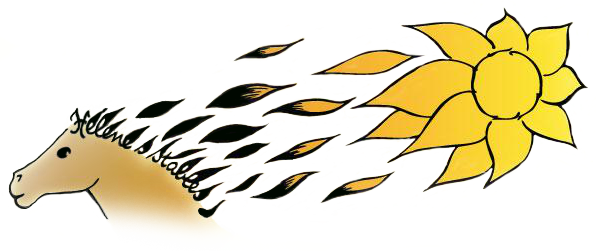The Horse’s Life at Hélène’s
 Horses are kept in an environment as close as possible to what nature has to offer. They live all together most of the time. The animal never gets locked inside the stall, unless it is sick and needs to be observed in a controlled area. The indoor arena is always available to them when the weather is difficult to tolerate like winter snow blizzards or hot summer and buggy days. They are allowed to develop and practice their pecking orders as nature dictates. All herd animals need to display these behavior to maintain their social stability.
Horses are kept in an environment as close as possible to what nature has to offer. They live all together most of the time. The animal never gets locked inside the stall, unless it is sick and needs to be observed in a controlled area. The indoor arena is always available to them when the weather is difficult to tolerate like winter snow blizzards or hot summer and buggy days. They are allowed to develop and practice their pecking orders as nature dictates. All herd animals need to display these behavior to maintain their social stability.
Hélène’s Approach
The emotional and psychological connection between the horse and the student is one major ingredient in horseback riding. The fact that riding is not only a sport and an artistic expression, but also a genuine personal encounter between the animal and the human is never highlighted enough. Beside learning how to ride, the student primarily achieves a connection with the animal. Learning how to give, in the form of petting, scratching a favorite spot, hugging, whispering gently, will invite the horse to reciprocate. Horses know when a human feels love, hate, fear and more. Every time we experience these feelings, our body unconsciously releases chemicals that the horse is capable of smelling. Our gentle furry friend who has learned how to trust and who can read our positive emotions is usually likely to reciprocate, which in return, has a major impact on the child’s self esteem. The young individuals, especially the one who have physical and/or emotional delays, will particularly benefit from entering this communion with the horse.
Each horse at Hélène’s has a personality, like another horse at any other barn. Every student can describe the special traits that characterize the animals here, though. They not only know how different they feel and respond when ridden, but they can distinctly describe them as pets. They are taught to express their feelings to the horses through body language. Their partnership with their favorite horse starts long before they mount the animal for their scheduled ride. The horse is an animal who is so sensitive that a simple stroke on the neck a few consecutive times is enough to start a bonding relationship. There is no doubt that once the student has established that basic connection with the horse, riding turns into a genuine partnership.
 Why Bareback too?
Why Bareback too?
The saddle is an important element of horseback riding. There is a long and valuable tradition behind them. Centuries of work leave us contemplating all the work involved in making one. Every culture has its own particular designs and leather cuts. History can be read through the details engraved into them. Each riding discipline has its particular design. Proper learned skills will ensure a safe seat. An additional approach that Hélène offers is the bareback riding. Riding the horse bareback calls for a natural sense of balance. The instinctive moves play an important role. The student is in direct contact with the horse. Every move made will reflect on the horse execution and or confusion as well. This form of riding allows a more precise and elaborate communication with the horse, involving our lower body aides in a more refined manner. One single gluteus muscle of ours flexed will be felt by the animal, no need to accentuate our weight on it – just isolate the movement. And this goes the other way as well: a simple tightening of the shoulder muscle on the horse part will indicate the engagement of the whole leg so that the rider can predict what the animal is up to. By the same token, resistance and lameness can be detected too whereas the stiff muscle can be felt, besides the clumsy and uneven motion from the four legs.
Bareback riding does not appeal to everyone or to every culture. A lot of countries in Western Europe recognize this form of equitation as a basic one. It is required to master in order to pass various examinations prior to entering the dressage domaine. The saddle still remains very popular in the United States. It has earned a great deal of respect throughout the years. It is unfortunate though that the bareback practice is, for some, still considered as a primitive, backyard activity. At Hélène’s Stables, we regard it as the most fundamental approach to sit properly and to move in tune with the animal. It also keeps our buttocks warm in the winter!
